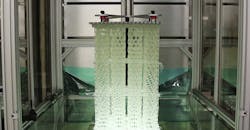Now You Can 3D-Print Yourself in an Afternoon
Northwestern University researchers have developed a new 3D printer that can print an object the size of an adult human in just a couple of hours.
The prototype HARP technology is 13-feet tall with a 2.5 square-foot print bed and can print about half a yard in an hour—a record throughput for the 3D printing field. This means it can print single, large parts or many different small parts at once. This is considered a breakthrough, as often, the pursuit of larger parts has come at the cost of speed, throughput, and resolution.
“3D printing is conceptually powerful but has been limited practically,” said Northwestern’s Chad A. Mirkin, who led the product’s development.
“If we could print fast without limitations on materials and size, we could revolutionize manufacturing. HARP is poised to do that.”
Mirkin predicts that HARP will be available commercially in the next 18 months.
The results were published on Oct. 18 in the Science journal. Mirkin is the George B. Rathmann Professor of Chemistry in Northwestern’s Weinberg College of Arts and Sciences and director of the International Institute of Nanotechnology.
David Walker and James Hedrick, both researchers in Mirkin’s laboratory, co-authored the paper.
Keeping It Cool
HARP uses a new, patent-pending version of stereolithography, a type of 3D printing that converts liquid plastic into solid objects. HARP prints vertically and uses projected ultraviolet light to cure the liquid resins into hardened plastic. This process can print pieces that are hard, elastic or even ceramic. These continually printed parts are mechanically robust as opposed to the laminated structures common to other 3D-printing technologies. They can be used as parts for cars, airplanes, dentistry, orthotics, fashion, and much more.
A major limiting factor for current 3D printers is heat. Every resin-based 3D printer generates a lot of heat when running at fast speeds—sometimes exceeding 356°F (180°C).
Not only does this lead to dangerously hot surface temperatures, but it also can cause printed parts to crack and deform. The faster it is, the more heat the printer generates. And if it’s big and fast, the heat is incredibly intense.
‘Liquid Teflon’
The Northwestern technology bypasses this problem with a nonstick liquid that behaves like liquid Teflon. HARP projects light through a window to solidify resin on top of a vertically moving plate. The liquid Teflon flows over the window to remove heat and then circulates it through a cooling unit.
“Our technology generates heat just like the others,” Mirkin said. “But we have an interface that removes the heat.”
“The interface is also nonstick, which keeps the resin from adhering to the printer itself,” Hedrick added. “This increases the printer’s speed by a hundredfold because the parts do not have to be repeatedly cleaved from the bottom of the print-vat.”
A world-renowned expert in nanotechnology, Mirkin invented the world’s smallest printer in 1999. Called dip-pen nanolithography, the technology uses a tiny pen to pattern nanoscale features. He then transitioned this to an array of tiny pens that channels light through each pen to locally generate features from photo-sensitive materials. The special nonstick interface used in HARP originated while working to develop this technology into a nanoscale 3D printer.
“From a volumetric standpoint, we have spanned over 18 orders of magnitude,” Mirkin said.
The study, “Rapid, Large-Volume, Thermally-Controlled 3D Printing Using a Mobile Liquid Interface,” was supported by the Air Force Office of Scientific Research (award number FA9550-16-1-0150), the U.S. Department of Energy (award number DE-SC0000989) and the Sherman Fairchild Foundation.
EDITOR'S NOTE: Mirkin, Walker, and Hedrick have financial interests in Azul 3D, Inc., a company that has licensed HARP intellectual property (U.S. patent application 62/815,175). All three have affiliations with Azul 3D, Inc. Northwestern University has financial interests (equity, royalties) in Azul 3D, Inc.
About the Author

Amanda Morris
Senior Editor of Science and Engineering - Northwestern University
Working in Northwestern's Global Marketing and Communications office, Amanda Morris writes press releases and manages media relations for engineering and physical sciences. She also works on the creative marketing side for Northwestern to develop strategic, innovative ways to tell the University's research stories.
